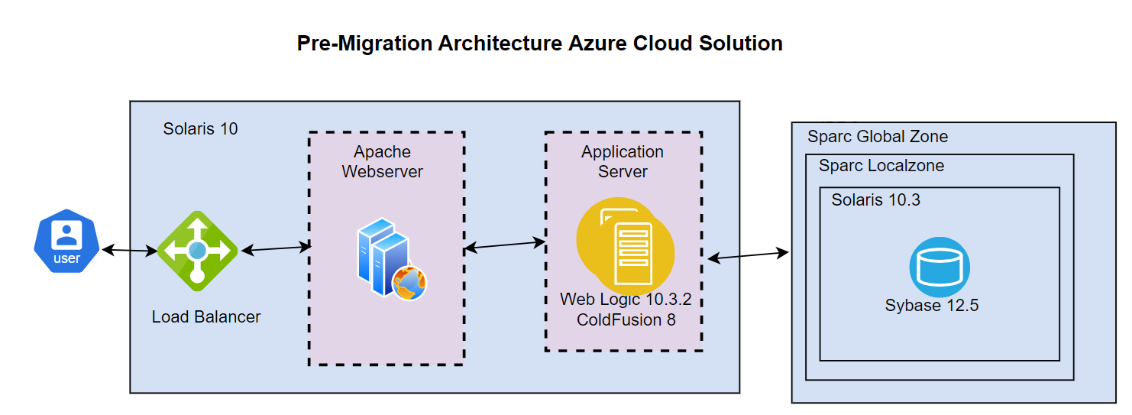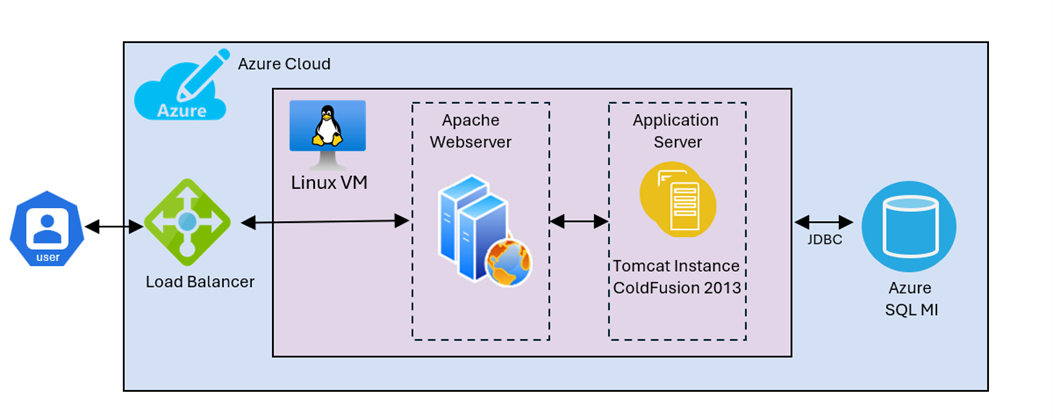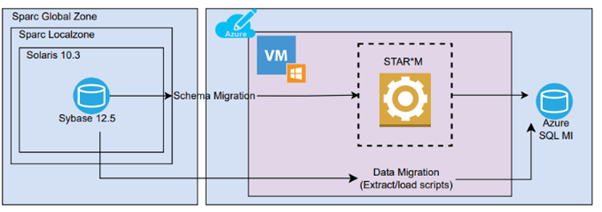

Transforming Legacy Systems: A Successful Midrange Solaris Modernization Project for a Federal Customer

Industry: Public Sector
Headquarters: U.S.
Coverage: Nationwide
Our Customer
With the acceleration of technological evolution, organizations must move beyond outdated legacy systems to stay competitive. Modernization isn’t just an upgrade—it’s a strategic initiative that drives efficiency, fortifies security, and ensures long-term scalability in a digital-first world. A Federal customer (“Customer”) recently embarked on a significant modernization journey, transitioning their Midrange Solaris/Sybase ASE environment to Microsoft Azure. Partnering with mLogica and Microsoft, the project successfully streamlined operations and positioned the Customer for future growth.
Background
The Customer faced increasing challenges in maintaining their aging midrange Solaris systems, requiring a move to a modern cloud-based infrastructure. With a vision to exit their current data center and meet a tight migration timeline, they sought a robust and scalable cloud platform. The goal was to enhance performance while ensuring security and compliance.
Key Project Stakeholders
- mLogica: A leading provider of IT modernization solutions, mLogica brought their expertise in migrating and modernizing legacy systems to the project.
- Microsoft: Leveraging the power of Microsoft Azure, the project aimed to provide a robust and scalable cloud platform for the Federal customer's applications and data.
Challenges
Project Overview / Customer’s Business Objectives
The Customer’s legacy systems were holding them back, and time was running out with the deadlines of exiting their Datacenters. A transition to Azure was necessary, but the complexity of their applications, databases, and infrastructure posed a significant challenge. A rushed or unstructured migration could lead to costly downtime, data loss, or operational disruptions, or complete project failure.
The Customer operated fifty (50) on-premises Solaris servers across five data centers, hosting multiple applications running on legacy Sybase ASE databases. The objective was to consolidate these servers into the Azure cloud platform, starting with two applications as a pilot:
mLogica conducted a comprehensive analysis of the on-premise environment to determine the optimal migration path, assisting with an assessment of both database and application code, including downstream, and upstream applications.
Migration Approach
mLogica, provided a structured, best practices migration methodology, along with its automated STAR*M technology and decades of expertise, designed a structured, phased migration approach—a well-orchestrated journey ensuring a seamless transition with minimal risk.
Step 1. Assessment and Planning
Before embarking on the migration, mLogica took a deep dive into the Customer’s existing environment. Every component—from databases and applications to middleware and operating systems—was meticulously analyzed.
Analyzing the Landscape
The assessment phase involved identifying upstream and downstream dependencies, analyzing data structures, and defining the optimal post-migration architecture. Risks were mapped, roadblocks were anticipated, and a precise migration roadmap was developed.

Database Deep-dive
mLogica reviewed the source code and data definitions, generated exception reports, and supported a thorough review process with the Customer. All source databases were identified (tables, views, stored procedures and other objects) and then categorized based on size, complexity, suitability for cloud migration, and the scope of changes required.
A comprehensive review of the existing Sybase ASE environment laid the necessary groundwork, and a migration plan was finalized with delivery milestones.
Finalizing the Target Environment
With a clear understanding of the existing Sybase ASE environment, mLogica and Microsoft defined the post-migration Azure architecture as shown in the figure below:

This structured assessment laid the foundation for a seamless, efficient migration to Azure.
Step 2. Migration Preparation: Laying the Foundation
With a clear roadmap in place, the next step was to prepare for migration. A staging environment was created to test database migration scripts, validate configurations, and prepare for a seamless cutover.
STAR*M is mLogica's automated, GenAI-powered Distributed Workload Modernization software, combined with structured, proven methodology and backed by decades of migration experience, is critical for ensuring successful legacy SAP/Sybase migrations to Azure with efficient execution and minimal downtime. With our deep understanding of legacy technologies and Azure cloud infrastructure, mLogica ensures each migration is successful and optimized for the business's unique needs, enabling enhanced performance, dynamic scalability, and long-term growth on Azure.
The Power of Automation
Using STAR*M (Schema Migration) software, customized migration scripts were generated to seamlessly transition schema objects—tables, indexes, keys, constraints, stored procedures, and more—to Azure.
Future-Proofing the System
Beyond just migrating data, mLogica helped Microsoft and the Customer define a new server architecture, ensuring high availability and disaster recovery capabilities in Azure. The foundation was now ready for full-scale migration.
Step 3. Migration to Azure - The Big Leap
With the groundwork laid, it was time for the most critical step—migrating data to Azure. A Seamless Transition
- The schema migration script generated in the previous phase was executed, establishing the database structure on Azure.
- The STAR*M Data Migration software then transferred data from Sybase to the new Azure database, ensuring a smooth transition.
- The STAR*M SQL tool converted Sybase SQL syntax to Azure SQL.
- The STAR*M Verification tool validated data integrity and correctness, ensuring the migrated system mirrored the original environment.
- The applications were now redirected to connect to the Azure database—Azure was officially the new home for the Customer’s critical systems.
The whole process is shown below:

Step 4. Testing
A successful migration isn’t just about moving data; it’s about ensuring everything works flawlessly in the new environment. mLogica and Customer performed a comprehensive testing of the application including:
- Functional Testing – Every query, stored procedure, and trigger was tested to confirm data accuracy and schema integrity.
- Application Testing – Business functionality was validated, ensuring users could operate without disruption.
No stone was left unturned—mLogica, Microsoft and the Customer worked together to verify the migration’s success.
Step 5. Deployment and Cutover - The Final Step
With everything validated, it was time for the big switch. A strategic Go-live. The applications were deployed and cutover was planned in accordance with the Customer over a weekend to minimize downtime, user impact, etc. As part of this process, mLogica worked with Microsoft and the Customer on the following:
- Hand over the customized schema and data migration scripts generated by STAR*M to the Customer for pre-production environment data migration
- Update the application and integration endpoints to Azure
- Validate the system in pre-production environment
- Schedule a cut-over date and develop a roll back plan
- Move the data to production
- Validate the system in production
- Continuously monitored performance and logs
- Provide support to resolve any issues promptly
Step 6. Post-Migration Support - A Smooth Landing
After the migration was completed successfully, mLogica supported the Customer with the following:
- Documentation & knowledge Transfer – A detailed migration blueprint was created for future reference.
- Held lessons-learned meeting.
- Ongoing support – Any post-deployment issues were swiftly resolved, ensuring a smooth operational transition.
The Benefits
Project Highlights: The mLogica & Azure Success Story
The success of this project was driven by mLogica’s automated STAR*M technology and migration cloud factory model, ensuring efficient execution with minimal downtime.
Automated Workflows: Precision & Speed
With STAR*M at the helm, tedious manual processes were replaced with intelligent automation. This not only reduced human error but also accelerated execution, ensuring a smooth transition with minimal downtime.
Meeting the Impossible Deadline
Time was of the essence since the customer had the target deadline to exit the Datacenter. By leveraging automation, the Customer successfully migrated the 2 critical applications in time. What seemed unachievable with manual methods became a reality, allowing them to quickly embrace Azure’s capabilities.
Cost Savings: A Smarter Approach
The financial impact was undeniable. Automation significantly reduced migration time and effort, translating into substantial cost savings. Beyond that, moving from legacy systems to Azure meant lower infrastructure expenses, reduced licensing fees, and minimal maintenance costs.
Security & Compliance: A Fortified Future
Security was paramount. Azure’s advanced encryption, identity management, and threat detection provided the highest level of data protection. Additionally, the migration met all federal compliance requirements, ensuring the Customer operated within a fully secure and compliant environment.
Optimized Performance & Scalability
With Azure’s flexible architecture, the Customer’s systems could now scale effortlessly to meet evolving business demands. Applications ran faster, improving both performance and user experience.
Cost Efficiency: Pay for What You Use
Gone were the days of maintaining expensive legacy infrastructure. With Azure’s pay-as-you-go model, operational costs dropped significantly, freeing up resources for innovation and growth.
CONCLUSION
What started as a daunting challenge transformed into a remarkable success story. Thanks to mLogica’s automation-driven approach and Azure’s cutting-edge capabilities, the Customer not only met their goals but unlocked a future of efficiency, security, and scalability in the cloud.








































